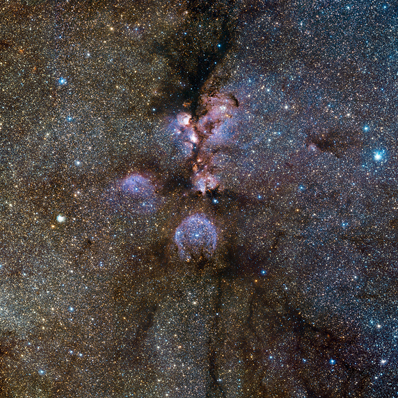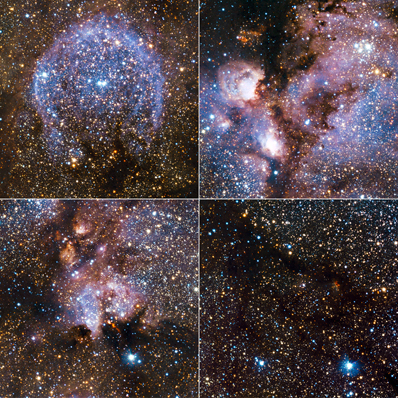


|

|
 |
|
VISTA strikes again KEITH COOPER ASTRONOMY NOW Posted: 22 April The Visible and Infrared Survey Telescope (VISTA), perched atop the 2,635-metre high peak of Cerro Paranal in Chile’s Atacama Desert, has provided revealing new images that penetrate the thick gas and dust shrouding one of the most active star-forming regions in the Galaxy: the Cat’s Paw Nebula.  VISTA’s view into the Cat’s Paw Nebula, taken through Y, J and Ks filters (false-colour red, green and blue respectively), with exposures of five minutes per filter. You can find a larger version of the image here. Image: ESO/J Emerson/VISTA.
VISTA’s view into the Cat’s Paw Nebula, taken through Y, J and Ks filters (false-colour red, green and blue respectively), with exposures of five minutes per filter. You can find a larger version of the image here. Image: ESO/J Emerson/VISTA.
Residing 5,500 light years away in the direction of the constellation Scorpius, the Cat’s Paw (more properly known as NGC 6334) is a dense cloud of molecular (HII) hydrogen gas that is forming stars. In visible light images, the starlight from the young stars illuminates the surrounding gas, causing it to glow and reveal the distinctive shape that gave rise to its name. However VISTA, the world’s largest survey telescope with a 4.1-metre mirror, operates at near-infrared wavelengths that can see through most of the gas and dust, leaving only a hint of the ‘paw print’ (you can compare the VISTA image with a visible light image captured by the European Southern Observatory’s 2.2-metre telescope, here).  Close ups of sections of the CatŐs Paw. Image: ESO/J Emerson/VISTA.
Close ups of sections of the CatŐs Paw. Image: ESO/J Emerson/VISTA.
What VISTA, which is also operated by ESO, has found are hundreds of young stars, some as many as ten times the mass of the Sun. The observations, which span the entire 50 light years of the nebula thanks to VISTA’s enormous 1.65-degree field-of-view, provide an insight into the first few million years of these stars’ lives. That said, there are some regions that not even VISTA, with the world’s largest infrared camera, can penetrate. At the very centre of the nebula are some orange-coloured regions that are areas where the gas is so thick it blocks even infrared light. This region is host to the youngest stars, with their polar jets heating the surrounding gas. Far from being meek pussy cats, these youngest of stars are actually fiery lions that have inscribed their paw print upon the Galaxy. You can read much more about VISTA, its six giant surveys and the camera and filters it employs in the May 2010 issue of Astronomy Now, on sale now from both newsagents and our online store. You can also watch our exclusive interview with leading VISTA scientist Professor Jim Emerson, of Queen Mary University of London, filmed at the National Astronomy Meeting in Glasgow last week, here. |
|
|
|
|